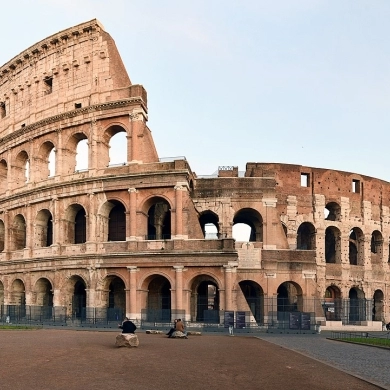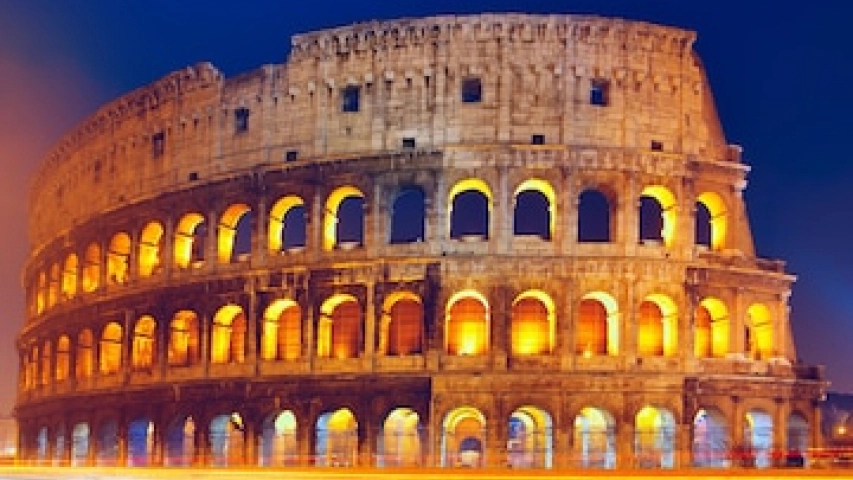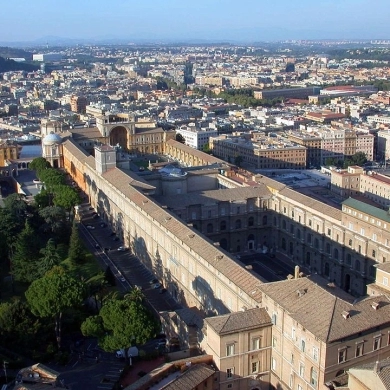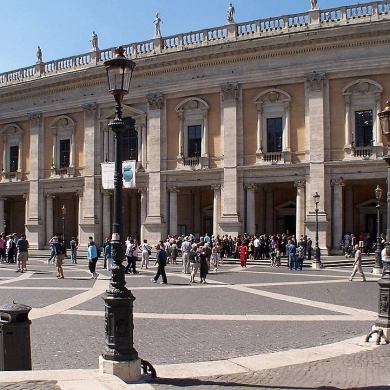Welcome to Rome, known as the Eternal City. According to legend, the city was founded by the two brothers Romulus and Remus on April 21, 753 BC. The legend states that the brothers had a disagreement about where to settle, leading to Romulus killing Remus. The city was then settled on the banks of the Tiber River.
Rome is the capital of the Lazio region and Italy, and is the most populous city in the country with almost 3 million people. It is also the third most populous city in Europe. The history of Rome spans 3,000 years, and it was the first great city of humanity, influencing all aspects of society including architecture, art, gastronomy, philosophy, religion, law and more.
At its height, Rome spread throughout the Mediterranean area, North Africa, Europe, and the Middle East. Rome is the city in the world with the most architectural and historical assets per square meter. Its historic center is delimited by the Aurelian walls, which were designed to stop barbarian attacks. The walls are about 12.5 km in length today.
Rome is also home to the Vatican City State, which is also worth visiting. In 1980, Rome was included in the list of World Heritage Sites by UNESCO due to its many incredible monuments and buildings such as the Roman Forum, the Colosseum, and St. Peter's Basilica.
Rome is a perfect holiday destination due to its climate, proximity to the Mediterranean Sea, delicious gastronomy, friendly locals, and accessibility for people with reduced mobility. Many public places can be accessed for free without waiting for people in wheelchairs, and over 80% of the buses are also wheelchair-friendly. However, it should be noted that many streets in the center of Rome are not perfectly paved and may be difficult to access in a wheelchair.
Some important facts about Rome:
- Its currency is the €uro.
- The telephone prefix is (+39).
- The time zone is GTM + 1.
- In 2019, more than 65 million people visited Italy, from that over 10 million visited Rome.
- Around 18:00 is aperitif time in Rome, when Romans go out for drinks and socializing with neighbors and friends. (We recommend you try the Spritz).
- In Rome the diet is very varied (Mediterranean), but we will say that his favorite food is pasta in any of its forms.
- The Vatican is the smallest country in the world, with a population of 900 inhabitants and an area of just 44 hectares.
- Giolitti is the oldest ice cream parlor in the city, open since 1890, you can not forget to stop by, if you travel to Rome.
- The most important holidays in the city are August 15 for the Assumption and June 29 (San Pedro and San Pablo)
From www.motion4rent.com we bring you some of the important information, places of interest and tourist offices, through the accessible beaches, to the adapted excursions, theme parks, accessible restaurants and other offers for visitors with reduced mobility. Enjoy your stay!.
Rome has several tourist information points, here we show you the most important, these points are open 365 days a year, located at strategic points in the city and at the airports, they are the point of reference for all those who visit the Capital.
In all these points we will find multilingual staff, and in them, in addition to information, we will be able to buy tickets for monuments, transport passes or make hotel reservations... And in all of them you can pay with a credit or debit card.
Information point Termini:
This information point is located in Termini central station, it is open every day of the year, it is accessible to people with reduced mobility and it is there that we can get information and buy tickets for most of the city's attractions, such as the Coliseum, Vatican Museums, tourist bus, and much more.
Address and contact:
- Via Giovanni Giolitti, 34 – Building F – Via 24
- Telephone (+39) 060608
Information Point Minghetti
This information point is located very close to the Trevi Fountain, it is open every day of the year, we do not know if it is accessible for people with reduced mobility.
At this information point you can find maps, guides and of course its staff can help you with any questions you have about the tourist attractions in the capital. You can also buy transport tickets and tickets for most famous monuments of the city.
Address and contact:
- Via Marco Minghetti, Angolo Via del Corso, 00187 Rome RM, Italy
- Telephone (+39) 060608
Information point Castel Sant'Angelo
This information point located in Piazza Pia and open every day of the year, is accessible to people with reduced mobility and also its bathrooms. Like all information points, it has multilingual staff and at this point you can access free maps and guides and you can also buy transport tickets and tickets for monuments and attractions in the city.
Address and contact:
- Piazza Pia, 00193 Rome RM, Italy
- Telephone: (+39) 060608
Information point Fori Imperiali
Open every day of the year and accessible to people in wheelchairs, it is an information point where you can get maps and guides of the city, you can also get tickets for the most important attractions, public transport or the tourist bus, among other services. It also has a small bar and toilets.
Address and contact:
- Via dei Fori Imperiali, 1, 00186 Rome RM, Italy
- Telephone (+39) 060608
Information Point Fiumicino Airport
This information point located in terminal 3 for international arrivals, is accessible to people with reduced mobility and also has adapted toilets, at this point as in the points of the city, you can get maps and guides of Rome, you can also buy the Roma Pass, transport tickets, tickets for museums and attractions in the city.
Address and contact:
- Via Leonardo da Vinci, 1025, 00054 Fiumicino RM, Italy (Terminal 3)
- Telephone: (+39) 060608
Ciampino Airport Information Point
This information point is located in the international arrivals terminal, it is accessible for people with reduced mobility and it also has adapted bathrooms. As in the rest of the information points, you can get guides and maps and they can also inform you of the most important tourist spots in the city. You can get tickets for public transport and for the different attractions of the city.
Address and contact:
- Via Francesco Baracca, 00178 Roma RM, Italy (International Arrivals Terminal)
- Telephone (+39) 060608
We want to start this point by saying that, like most major cities in Europe, Rome also has its transport card for tourists, in this case it is called ROME PASS.
The Rome Pass is a transport card for tourists that allows them to access public transport and main attractions of the city at a discounted rate. It is valid for 2 or 3 days and can be purchased at information points, airports, and major museums or monuments.
It is important to activate the card in the morning, as the validity ends at 23:59 on the second or third day. The card also includes a guide and map of the city, and offers free entrance to the first two monuments or museums chosen from a list.
Remember that the first two attractions are free, but from the third, you will have to go to the ticket office and present the card and ID.
Here are the most important attractions to which you will have access, but they are not the only ones:
- Colosseum, Roman Forum and Palatine.
- Trajan's Market.
- Capitoline Museums.
- Sant'Angelo Castle.
- Baths of Caracalla.
- Baths of Diocletian.
- Contact for Roma Pass
- Phone: (+39) 060608
- E-mail: info@romapass.it
Rome has 2 airports, the most important is Fiumicino, located 32 km from the city center and where the big airlines operate, the other airport is Ciampino, which is about 15 km from the center and where they usually operate low cost airlines.
FIUMICINO Airport
Fiumicino Airport in Rome offers ADR Assistance, a service provided by the Rome Airports Group for individuals with reduced mobility.
The ground assistance service must be requested from the airline at least 48 hours before the flight departure time.
For more information, travelers can visit the ADR Assistance website at www.adrassistance.it. In the departures terminal (Partenze), there are small columns called "Punti Richiesta Assistenza" (points to request assistance) where travelers can request ADR Assistance through an intercom.
In addition, at Fiumicino airport there are the following services:
- Interactive points with information on flights and facilities at Fiumicino Airport.
- All airport toilets are accessible to people with reduced mobility
- All elevators are wheelchair accessible.
- In the departures terminal they have medical assistance.
- Carabinieri police telephone: (+39) 06 65954040 (24 hours).
- Rome Fiumicino Airport Emergencies: (+39) 06 65953133/4.
Transfer from Fiumicino Airport to the center of Rome:
In this aspect we can choose between 5 modes of transport, but not all of them are accessible to people with reduced mobility.
- Leonardo Express direct train:
The Leonardo Express direct train is a convenient and accessible option for travelers with reduced mobility. It is fully accessible for individuals with disabilities and it takes only 32 minutes to reach the Termini station in the city center, making it the fastest transportation option. It's a great option for those who want to reach the city center quickly and comfortably.
This is a little slower, as it makes stops in Trastevere, Ostiense, Tuscolana and Tiburtina, so the approximate time to get to Rome is 1 hour; It has a toilete, but only 1 is accessible to people with wheelchairs.
Additionally, you should know that they do not have air conditioning and their departures are not as frequent as the Leonardo Express, but it is cheaper. For this option you can request assistance from RFI (Italian Railway Network) as follows:
- Going directly to Sale Blu (Located at the airport station) if you want, you can contact them before traveling at the following email: SalaBlu.ROMA@rfi.it
- Calling the National RFI Telephone (+39) 199 30 30 60
- By contacting the Trenitalia Call Center: (+39) 199892021 option 7 or 06/3000 for users not able to call 199
This is one of the cheapest options to get from Fiumicino to the center of Rome, but you should know that not all bus companies are accessible.
There are several private companies that provide this service, but we recommend SIT BUS SHUTTLE, since it is the only one that you can travel with if you are in a wheelchair, but remember that they only accept folding chairs. The bathroom inside the bus is accessible. You must bear in mind that, depending on the traffic, the bus can take between 30 min and 1.20 h to cover the 32 km route that separates the airport from the Termini bus stop (Rome Center), which is where the bus will drop you off.
It is the most expensive option, but also the most comfortable. There is usually no problem finding adapted taxis to take you to the city center, once you collect your luggage you just have to go to the airport exit and you will find the taxi rank. Any way, we recommend you contact this company https://www.3570.it/services/accessibile as it has more than 50 adapted vehicles.
As in most large airports, you will be able to find car rental companies and practically all the large rental companies have cars adapted to be able to get in a wheelchair. (we recommend booking before traveling to confirm that they have adapted cars)
CIAMPINO Airport:
This airport, located just 15 km from the city center, is smaller than Fiumicino and only has one terminal. As previously mentioned, it is the airport that low-cost companies usually use.
If you are traveling in a wheelchair, remember that Rome has ADR Assistance, a company of the Rome Airports Group. This is a service for people with reduced mobility. The ground assistance service must be requested from the airline within 48 hours before the flight departure time. For more information, we recommend consulting the website directly: www.adrassistance.it.
At the airport, assistance can be requested at Assistance Request Points, which are columns equipped with a button (intercom) and a proximity sensor that activates an audible signal when approaching the customer. Through this intercom, you can contact ADR operators, who are in charge of activating the passenger assistance procedure.
The columns are easily identifiable, accessible, and usable by all disabled passengers. Assistance is provided from the moment of signaling the presence. The staff assists passengers throughout their stay at the airport. Assistance request points are located in the departures terminal: inside car park P3, which is dedicated to disabled passengers.
Transfer from Ciampino Airport to the center of Rome:
This airport, as we have mentioned, is about 15 km from the center of Rome and to get to the center there are several transfer options.
Not the best option if you're in a wheelchair.
This option combines the bus and the train from the airport to the city center, but remember that the train station is not at the airport, so you must transfer, first you must take the ARTAL company bus (Not all the buses of this company are accessible to PMR, only those with the wheelchair symbol on the front.) This bus will take you to the train station (This journey takes about 10 minutes) once at the station you can take the train that takes you to Termini (the city center)
You can buy tickets online and in case you miss the bus, you can use it on the next one without any problem.
There are several private companies that provide this service, but we recommend SIT BUS SHUTTLE or ARTAL, (Remember that the ARTAL company has some adapted buses, not all of them, and the SIT BUS SHUTTLE company only accepts folding chairs. In both cases, the bathroom inside of the bus is accessible.
You should bear in mind that, depending on the traffic, the bus can take between 30 minutes and 1 hour to cover the 15 km route that separates the airport from the Termini bus stop (Rome Center), which is where the bus will drop you off.
This is the option that we recommend if you are in a wheelchair, it is true that it is not the cheapest, but it is the fastest and most comfortable. We recommend you contact https://www.3570.it/services/accessibile as this company has more than 50 adapted vehicles.
As in most of the big airports, you will be able to find car rental companies and practically all the big rental companies have cars adapted to be able to get in a wheelchair. (we recommend booking before traveling to confirm that they have adapted cars)
Transportation within the city:
Train:
Trenitalia is the most important national train company in Italy and provides local, medium, and long-distance train service, as well as high-speed and night trains.
Thanks to a 2007 law, people with reduced mobility, pregnant women, the elderly, or those with any type of hearing, mental, or visual disability have the right to assistance when traveling by train.
For them there is a point called Sale Blu, which can be accessed at most stations to request assistance in the following way:
- Going directly to Sale Blu (Located at the airport station) if you want, you can contact them before traveling at the following email: SalaBlu.ROMA@rfi.it
- Calling the National RFI Telephone (+39) 199 30 30 60
- By contacting the Trenitalia Call Center: (+39) 199892021 option 7 or 06/3000 for users not able to call 199
Sale Blu points are located in 14 main stations, (Termini is one of them) These offices are open every day, including weekdays and holidays, from 6:45 a.m. to 9:30 p.m. and offer information and reservations of the assistance services, which can be provided 24 hours a day at all stations in the network.
The support services, free of charge, consist of:
- Greet passengers at the station at the agreed meeting point or, in the case of incoming passengers, at their seat on board the train,
- Meet passengers at the station to collect their tickets, if applicable,
- Escort passengers aboard the departing train to their assigned seating position or from the arriving train to the station exit or, for those continuing their journey, to board another train.
- Provide, upon request, a wheelchair for accompanying passengers to/from the train at the station,
- Getting on and off the train by means of a forklift for wheelchair passengers,
- A hand luggage service (1 piece of luggage) if necessary.
If the passenger requiring assistance is not self-sufficient, the service can only be provided if they have a personal assistant at the station or a person accompanying them during the trip.
- Termini: It is the most important station in Rome and trains arrive from all over Italy and also from the rest of Europe, the station is accessible for people with reduced mobility, it has accessible toilets, it has Wi-Fi, accessible restaurants and cafeterias, left-luggage 24 hours a day and it is one of the 14 stations in Italy that does have a physical Sale Blu office.
- Tiburtine: This station is the second most important in Rome, but it is not as central as Termini, since it is about 4 km from the city center. This station does not have a physical Sale Blu office, so if you need assistance you must request it at least one hour before the departure of the train, as long as you travel between 8:45 in the morning and 22:30 at night. If you arrive or leave outside these hours, you must contact Sala Blu 12 hours in advance to receive assistance. The Roma Tiburtina baths are wheelchair accessible and cost around one euro.
Metro:
Rome only has 3 metro lines (A, B and C) and more or less half of its stations are accessible to people with reduced mobility.
IMPORTANT: Many times the accesses for wheelchairs are broken or out of service, for this reason, we leave you this link of the public transport company of Rome (ATAC) in which they report in real time the incidents in their stations in regarding accessibility: https://www.atac.roma.it/tempo-reale/accessibilit%C3%A0-e-servizi
- Line A: This line crosses the city from Northwest to Southeast and has 27 stations, the headwaters are Battistini to the Northwest and Anagnina to the Southeast, this line is represented in orange. Its hours are from 05:30 to 23:30 from Monday to Sunday. Of the 27 stations, two are connected to the metro network (Termini, on line B, and San Giovanni, on line C).
- Line B: This line represented in blue, crosses the city from south to northeast and has 26 stations and its headwaters are Laurentina and Rebibbia. Since 2012 it has had an expansion, called B1, which extends to the north. Its hours are from 05:30 to 23:30 from Monday to Sunday. It has only one connection with the metro network, at Termini station (line A).
- Line C: This line has 22 stations and runs from north to east of the city. Its current headers are Monte Compatri - Pantano (to the east) and San Giovanni (in the historic center) and it is represented in green. Its schedule like the other two is from 05:30 to 23:30 from Monday to Sunday.
Bus:
Rome is greatly improving accessibility on city buses, with approximately 80% of its fleet being accessible thanks to boarding platforms and designated areas for wheelchairs. In addition, all new station platforms and those undergoing renovation are built in compliance with current legislation, equipped with access ramps and tactile pavements to allow access for all users.
Remember that the ticket is valid for 100 minutes from the first time it is stamped and can be used consecutively within that period on multiple buses.
We have listed some of the most popular destinations and the buses that can take you to those tourist spots.
- Coliseum: Numbers: 117, 175, 186, 271, 53, 571, 571, 75, 80, 810, 85, 87, 204, 81, 40, 60. The night bus is the N2.
- Saint Peter's Square: Numbers: 62 and 64, also lines 190, 916, 46, 98, 982 46 and 881 and from Termini station number 40 leaves, which also takes you to Saint Peter's Square.
- Central Rome Piazza Venezia Number: 30,40,62, 64,70,81,83,160,170,628. Night: 15,18,7,8,9
Taxi:
In Rome, there are more than 8,000 taxis, but not many are adapted for people with reduced mobility. One option for accessible taxis is Radio Taxi 3570. You can call their base and an operator will help you schedule a pickup with an adapted taxi. This company has over 50 adapted taxis, and their rates are the same as any other taxi in the city.
Touristic bus:
The Big Bus Tours Rome company has several buses adapted for people with reduced mobility. This company offers several routes, but we recommend the red route as it covers most of the city's monuments and attractions.
The buses have audio guides available in several languages and tickets can be purchased at various kiosks, as well as at Termini station or the Colosseum, and on their website.
The frequency of the buses is every 10-20 minutes, with the first bus departing at 09:00 am and the last one at 19:00 pm. The main stop is at Termini (Rome Central Station), but you don't need to start the tour at Termini, you can get on and off at any of the stops. The entire tour lasts one hour and forty minutes, and prices vary depending on the chosen route. Children under 5 years old can ride for free.
Trajan's Market:
It is important to begin by saying that this monumental complex is adapted for disabled and wheelchair access.
This architectural complex, which is currently semi-demolished, was built at the beginning of the 2nd century AD. and has lived through the evolution of the city of Rome from the imperial era to the present day and during these almost two millennia it has been given all kinds of uses, beginning as a commercial center with all kinds of small shops selling fresh products, continued as the administrative center of the Imperial Forums, it later became a noble residence, a military fortress, a convent...
All this important archaeological area was rediscovered in 1924, when Mussolini decided to build the current Avenue of the Imperial Forums (former Empire Way), since, until then, the Imperial Forums had remained hidden by a network of medieval and Renaissance houses (the Quartiere Alessandrino), of which some remains can still be seen.
Since 2007 there has been a museum that aims to illustrate the architecture within the ancient Roman Forum, in which we find reconstructions and models of the ancient buildings.
For the exhibition of the works, the museum uses traditional panels and multimedia technologies, which contribute to giving originality and an interactive character to the tour. The exhibition itinerary begins in the Great Hall, with the introduction to the Forum area and the representation of each one, through the most important findings.
The structure, in addition to the Museum of the Imperial Forums, hosts highly attractive temporary exhibitions.
Entry: Admission for people with reduced mobility or some disability is free, for him and a companion, there is also a special line “fast track” for people with a disability, which will save you the most likely queues. Their hours are:
- Open: every day 9.30-19.30
- Closed: 1st January, 1st May, 25th Dec. (December 24 and 31 closed in the afternoon)
Entry is allowed up to one hour before closing.
Toilets: The bathrooms are accessible to people with reduced mobility.
Accessibility:
To get to the Trajan Markets from Termini, the best option is bus 64, but you can also go by taxi or private vehicle.
Any public transportation that drops you off near Piazza Venezia will drop you off near Trajan's Market.
Trastevere neighborhood:
We want to propose a visit to this beautiful neighborhood of Rome, which, of course, is not all accessible by wheelchair, but a large part is, remember that many streets in Rome are cobbled, so perhaps the walk is somewhat bumpy, but sure it will be worth it.
Its name comes from the river that delimits the same neighborhood and its name in Italian means "over the Tevere"
It is a very charming neighborhood where you can walk and enjoy its narrow streets, bars, small charming restaurants with delicious food, terraces, cozy shops, and of course, many historical monuments.
The first place that comes to mind is Sidney Sonnino Square, which is located in the center of the neighborhood and from which we can reach any point in the neighborhood in a few minutes.
From the square and just 5 minutes away we have the Church of Santa María de Trastevere, which was one of the first churches open to worship in Rome, it is located in the Plaza de Santa María and in the center of it we find a beautiful fountain.
Tradition has it that oil (probably petroleum) began to sprout in this place and Pope Calixtus I, interpreting it as a sign of the coming of the Messiah, founded Santa Maria del Trastevere in this place in the first century (The church is now accessible). which is at street level and there is no architectural barrier).
In this neighborhood we also find the Villa Farnesina, an impressive 16th century construction that is also accessible to people with reduced mobility and in which we can see some frescoes made by none other than Rafael.
Another point that you cannot miss is the “Orto Botánico” Botanical Garden, which is also partially accessible for people in wheelchairs and has adapted toilets inside.
This botanical garden occupies 12 hectares of land in the heart of Rome and in them we find native species, but also many exotic species from different parts of the world.
The Botanical Garden is equipped for the disabled with a specific trail and two battery-powered vehicles that allow use of the park's trails.
Another thing that we suggest in this neighborhood is to do some shopping, since in its streets we find many small shops, antique shops, handicrafts and a fresh produce market that opens every morning and is located in the San Cosimato square.
There is also a market that only takes place on Sundays, it is the Porta Portese market.
Finally, mention that this neighborhood also has a lot of nightlife where you can go out for a drink and listen to good music... We invite you to get lost in its streets and discover a Rome that you did not imagine.
Hotel restaurant Locarno https://www.hotellocarno.com/
It is a 5* hotel in the center of the city, opened in 1925, with a classic atmosphere and magnificent terraces, both in the lower part and in the "Roof Top".
In addition to its accessibility, the Hotel Locarno also offers a range of amenities and services to ensure a comfortable and enjoyable stay for all guests. These include a fitness center, a spa, and a rooftop terrace with a view of the city.
The hotel also offers a concierge service and 24-hour room service. They also have a business center and meeting rooms available for those traveling on business. The hotel staff is also trained to provide personalized service and assistance to guests with disabilities.
- Address and contact:
- Via Penna 22 00186 Rome
- Telephone: (+39) 63610841
- Email: booking@hotellocarno.com
Libbra Restaurant https://www.libbraristorante.it/
Restaurant specialized in steaks and grilled meat, where you will also find an extensive wine list, it is located east of the Vatican, but very central, it has a wonderful garden with an area for children to play and Balinese beds where we can relax and have a drink before dinner.
In addition, the staff is trained to assist and accommodate customers with special needs. They also offer a wide variety of vegetarian options on the menu and will make any necessary adjustments to dishes for customers with dietary restrictions.
The restaurant's atmosphere is cozy and intimate, making it a perfect spot for a romantic dinner or a special occasion. The Libbra Restaurant combines delicious food, great wine and a welcoming atmosphere.
- Address and contact:
- Via Appia Nuova 889. 00178 Rome
- Telephone: (+39) 671280129
- Email: info@libbraristorante.it
Contemporary Voglia Trattoria: https://voglia-trattoria.it/
This restaurant is the fruit of the dream of two boys from Abruzzo (a region east of Rome) who have come to live in the big city and have wanted to bring their local recipes to the capital.
It is open from Monday to Sunday for both lunch and dinner and is located in the Trastevere neighborhood, known for its lively atmosphere and traditional Roman cuisine. The restaurant is also known for its friendly service and excellent value for money. It is a great option for those looking for a casual and authentic dining experience in Rome.
It is a modern place, its dishes are usually minimalist and are made with great care.
The place is 100% accessible for people with reduced mobility and its bathrooms are also accessible.
- Address and contact:
- Via Giuseppe Arimondi, 15. 00159 Rome
- Telephone (+39) 3487276818
- Email: info@voglia-trattoria.it









